2023
第八届网络社会年会发言稿
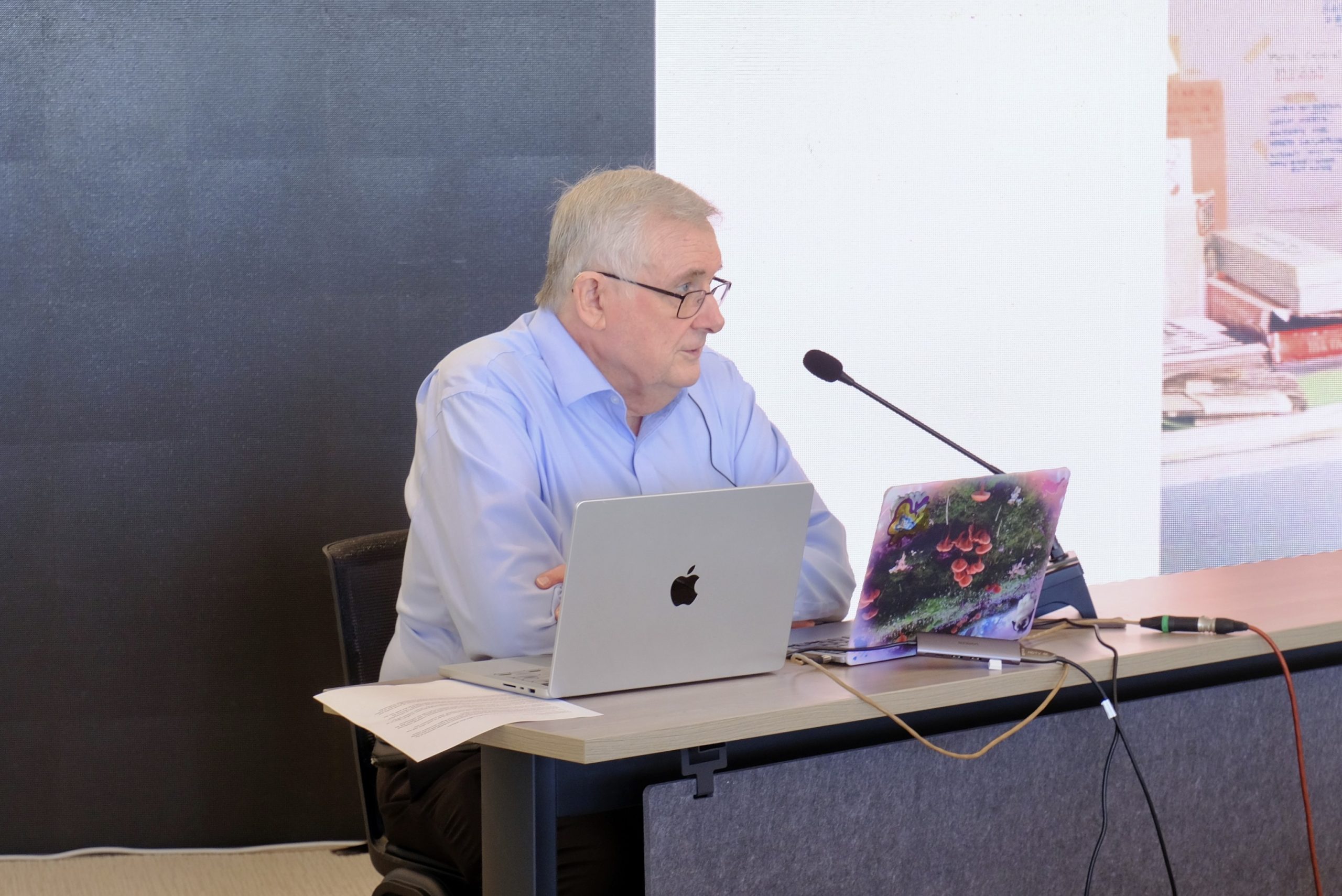
图 1 Lee Felsenstein 演讲现场图
谢谢。首先,我必须解释一下,我不是学者,我是一名工程师。因此,我不会试图去做一些基于事实的断言。我将会提出一些说法,并邀请每个人根据实际情况来检验这些说法。因为在工程领域,你总是在工具不完善、信息不充分的情况下工作,而且还必须产出一个能够满足必要功能的结果。而这始终是一个猜想的过程。因此,我邀请大家在此基础上对我和我的论断进行评判。
现在我们看到的这张照片(图 2),我把它称为社交互联网的起点。1964 年,我在伯克利的言论自由运动(Free Speech Movement)办公室违规拍摄了这张照片 [1]。现在这个场景看起来并不那么计算机化,因为在那个时候还没有计算机,只有电话。它看起来也不是很整洁,效率也不高。但是在这种低效中,我认为产生了一个至今仍在发挥作用的结果。我们可以(在图片中)看到人们正在忙着接听电话。那个时候只有两部电话。墙上的物品构成了一个数据库,随着人们的电话呼叫而不断变化。今天,在一家管理良好的公司里,电话室会井然有序,发送出去的信息或传输进来的信息,会被记录、分类整理,并传递给必要人员,信息双向流动,一切都条理分明,因为商业运作依赖于这一点。
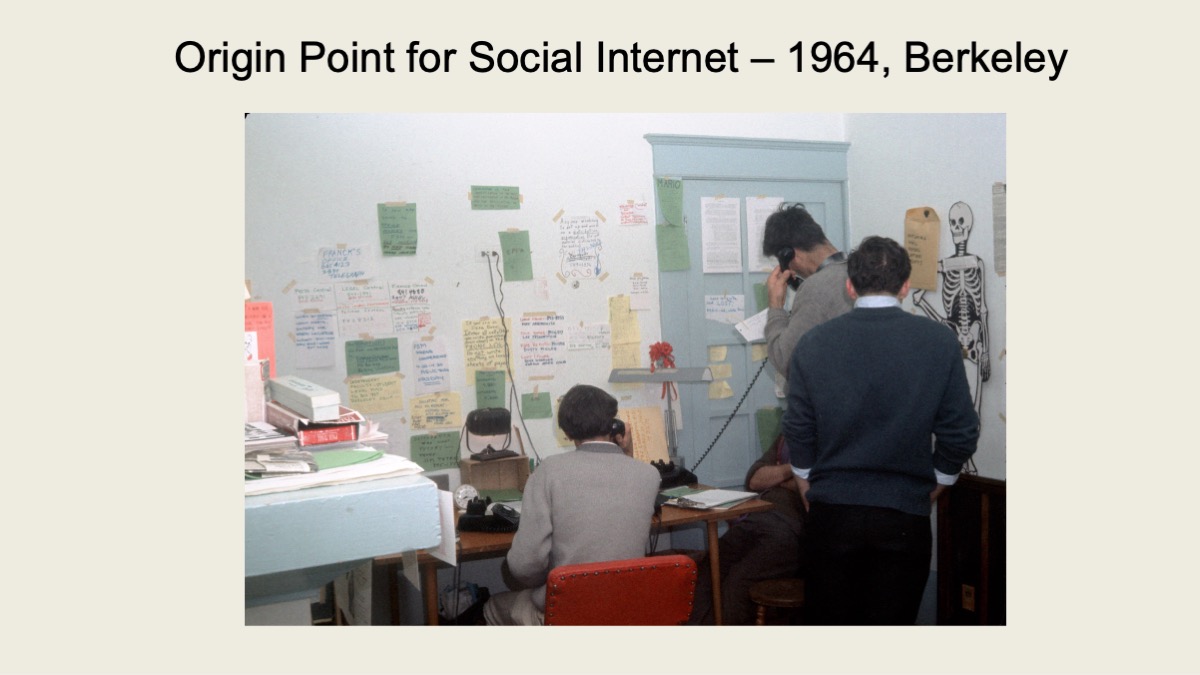
图 2 言论自由运动中心的电话室
这里发生的情况与此不同。人们以各种原因打电话过来。有时他们想要传达信息。有时他们需要解答问题。有时他们想提供资源。我记得在其中一份布告中,有人提供免费理发。因为那时候我们正迎来一个假期,人们回家见父母之前通常都需要理发。而且他们还为它取了个名字,叫做理发中心。当时我们有一个做法就是给所有事物都加上“中心”。这里(图 2)是在言论自由运动中心内。通过这组电话、桌子和这些人,各种联系都在建立。可以想到,你不能随便地让人进到办公室。信息不仅仅存在于人们的头脑中,也展示在墙上。之所以说这对 1964 年和未来都很重要,是因为它是校园社区形成机制的一部分。伯克利是一个很大的地方。在那个年代,伯克利大学有 2 万名学生。今天则有 3 万了。当时它因人际关系疏离而臭名昭著。当你来到学校,在熙攘的人群中,你是孤独的。你不认识任何人,其他人也不认识你,也不在乎你。当我到了伯克利大学的时候,我其实很喜欢那种氛围,但我是个特例。
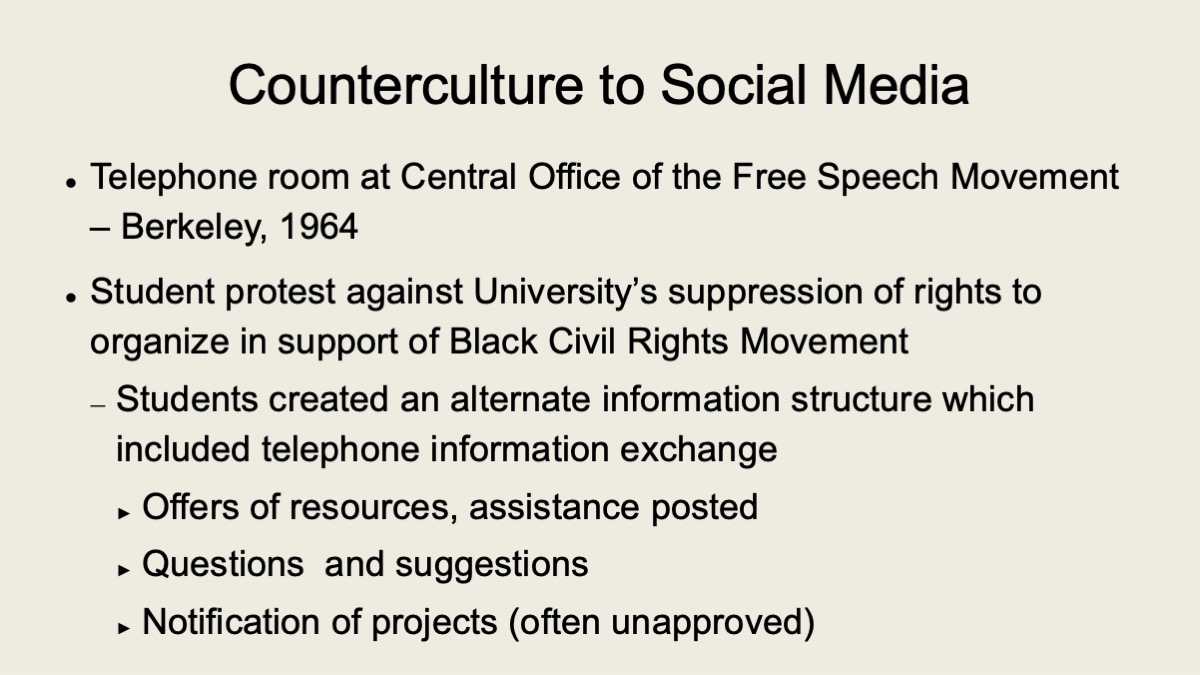
图 3 反文化到社交媒体
和我们昨天从意大利教授那里听到的情况相反 [2],自由言论运动所围绕的问题是,在当时民权运动正在向北方拓展的背景下,大学行政管理部门想要压制学生们组织支持运动的能力。事实上,1964 是一个特别的年份,因为在 1964 年夏天,自由之夏(Freedom Summer Project)吸引了来自全国各地的学生,他们尝到了密西西比和阿拉巴马州普遍存在的恐怖主义 [3]。之后有一些学生返回了,有一些没有。返回的这些人就好像是从战场回来的老兵一样。我还记得那种感觉。不是说我有这种感觉,而是那些人身上有,你能明显地感受到。
当时,学校颁布了一项新规定 [4]。这些学生团体在校园外摆起了桌子。人行道上有一面海报墙。成千上万的人在进出校园的路上蜂拥而过,他们可以在这些桌子上获取信息,捐款,还可以报名参加各种活动,包括当年在旧金山共和党全国大会长廊中举行的示威活动。当然,这背后也是 MAGA (Make America Great Again)运动先驱的巴里·戈德华特(Barry Goldwater) 和一个名叫斯克兰顿(Scranton)的温和派之间的争论。当地的政治领袖站在 MAGA 一方,他对学生在这些桌子上被招募到旧金山去参加大会,并抗议他的候选人感到不满。我们理解,我们没有确凿的证据表明他和其他人对管理层施加了压力,因为当时还在抗议就业歧视,有一些静坐示威,局势相当混乱。
因此,大学正面临来自外部的压力。他们发布了这项规定。但那完全是错误的时机,再次强调,因为公民权问题并不遥远,不仅存在于南方,而且已经直接逼到我们的门口了。从“自由之夏”回来的学生们都深度参与其中。因此,所有学生组织,无论是从极左到极右,从被摧毁的进步劳动党(Progressive Labor Party)到自由主义者。后者是类似个人主义者协会(Society of Individualists)之类的组织,他们的政治立场属于校园中的右翼,包括年轻的共和党人和加州政治行动保守派(Cal Conservatives for Political Action)。他们都团结在一起,形成统一战线来面对这个问题并进行抗争。而由于大学发现他们实际上拥有靠近路缘的人行道上的土地,我们无法将桌子搬出去。因此,桌子必须搬进校园内。我们采取了经典的公民不服从策略,即“填满监狱”。
我们在行政大楼前摆了桌子。如果在校园的任何地方都会被视为非法,那么这里是一个不错的地方。院长们会出来登记学生的名字以便进行处分。一旦他们登记了一个人的名字,另一个人就会站出来,包括我也被登记了。最终,在那一天,当学生被叫到院长办公室时,有 150 名学生出席。学校领导想要惩罚我们,但没能做到。第二天,也就是 1964 年 10 月 1 日,抗议活动继续进行。第一个非学生被指控。这对学校来说是一个幸灾乐祸的机会,因为去年通过的一项法律规定,任何未注册的学生或教职员工进入校园都将受到刑事处罚。他们抓到一个,也因此做了可能最愚蠢的事情。中午的时候,就在人群即将涌入的前不久,他们开来了一辆警车,然后把这个人,杰克·温伯格(Jack Weinberg)抓进了警车。你能想到接下来发生了什么吗?所有人都开始坐下,把警车包围住。事态越来越严重,一直持续了 32 个小时。最终双方谈判,达成了协议。
我们持续了两个月,直到最后在学校大楼进行了一场高潮迭起的静坐示威。我参与其中,当时有 784 名学生被捕。教职员工震惊了,他们认识到了局势的严重性。几天后,在他们的教师联盟中,以 80% 的支持比例投票支持学生的立场。这为获得政治支持提供了基础,导致大学的所有者,即董事会,做出让步并表示不会干预这件事了。因此,突然之间,校园对于任何类型的学生活动都持开放态度,无论是否经过大学的批准。在此之前,除非经过批准,否则你不能在校园里发传单。而现在你可以分发任何东西。
媒介结构
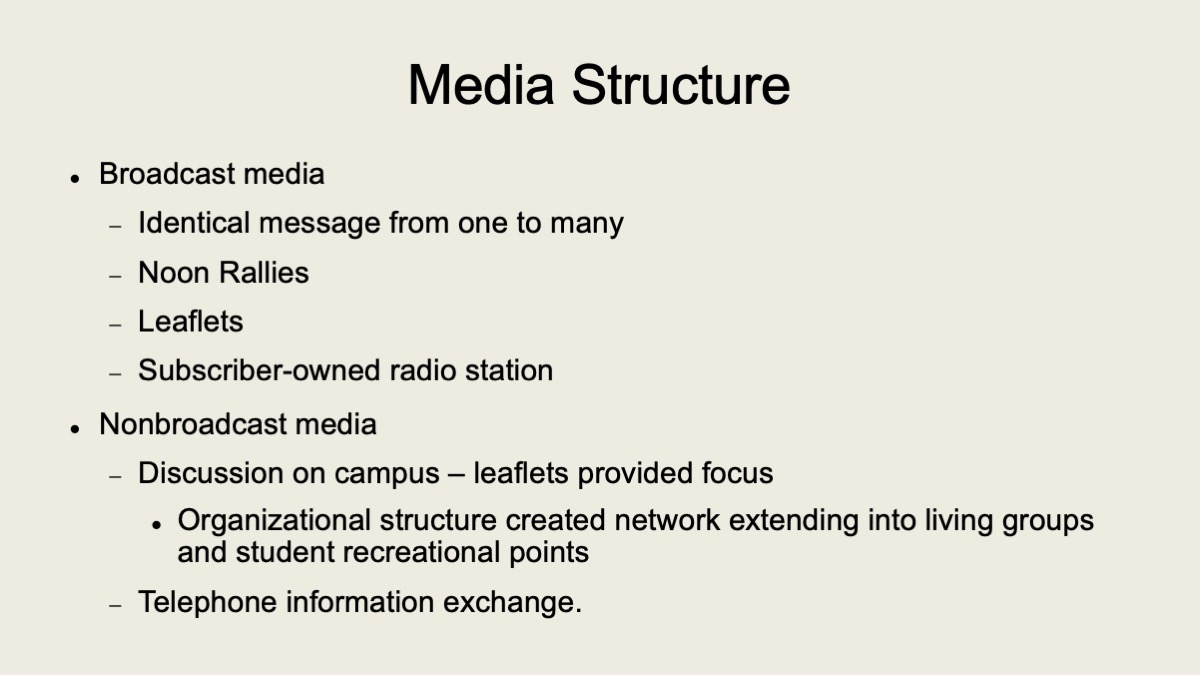
图 4 媒介结构
我想在这里谈一谈媒介结构的问题,因为这引起了我的思考。不是说它让我现在开始思考这个问题,而是从 1964 年开始我就已经在思考这个问题了。当时我是工程系的学生。我坚持一种观点,一种模糊的左翼观点,认为我未来的任务将是自动化和取代劳动力,这将在某种程度上推动社会进步。因为我没有课上,也没有作业,所以我就想去言论自由运动办公室工作。在那六个月的时间里,我一直在校园里工作。我的目标是找出作为一名技术专家我所能做的事情,因为这就是我认为我所能做的一切。我无法改变人们的思想,但我可以制造东西。我稍后会讲到那时候发生的事情。总之结果就是我走上了一条探索之路,试图找到哪些媒介技术是有效的。之所以这样说,是因为 1965 年 1 月,12 月是学年的最后一个月。当时的校园非常热闹。各种各样的人在不同领域里创作。这是我们没有预料到的。这是反文化的开端,尤其是在旧金山湾区。过去也有过反文化,但我们这里讨论的是 20 世纪 60 年代的反文化。我写了些小文章,有人发表了。当然,年轻的工科学生一般不会这么做,我们通常都保持沉默。但人们不再保持沉默,也不再待在一个地方。事实上,当时估计有数千名学生辍学,离开了大学,出现在海特阿什伯利之类的地方 [5]。他们形成了自己的社区。这是一切的关键。
我想在这里回顾一下媒介结构。在那前后不久,我对媒介进行了分析,将其分为两类:广播媒介和非广播媒介。广播媒介由单人向多人传播相同的信息。可以是印刷品,不一定非得是电磁传播。它可以在午间集会上进行。我们几乎每天都有午间集会。成千上万的人们会听到关于当前危机的消息。我们分发传单。我也帮忙制作了些传单,那是我能做的事情之一。人们早上来到校园,拿着我们分发的传单。他们冒着违纪的风险走出去分发。大家都知道(分发未经大学批准的出版物违反了学生行为规则)。每个人都成了讨论的焦点。人们会走过来问他们,你们为什么要这么做?发生了什么事?你们怎么看?我们在伯克利还有一个订户所拥有的广播电台,我认为这推动了整个进程,因为我们有了一种反馈循环。我们可以把信息传递到那个电台。它是非商业性的,由像我们这样的人运营着。
非广播媒介是围绕着传单发放者展开的讨论。我们建立了一个组织结构,有一个庞大的执行委员会,实际上它并不是执行性质的,但它有来自所有生活组织和其他组织的代表。这提供了一个双向信息通道。这些人参与制定政策,还有一个由他们选举产生的指导委员会,负责处理日常决策。在斗争过程中,实际上有一些指导委员会成员被替换,这在革命组织中有点不寻常。但我们建立了一条和所有选民保持联系的途径。我们还有在学生娱乐中心和艺术工作室工作的人。他们在那里进行讨论。我们利用电话系统进行信息交流。这也算作非广播媒介。
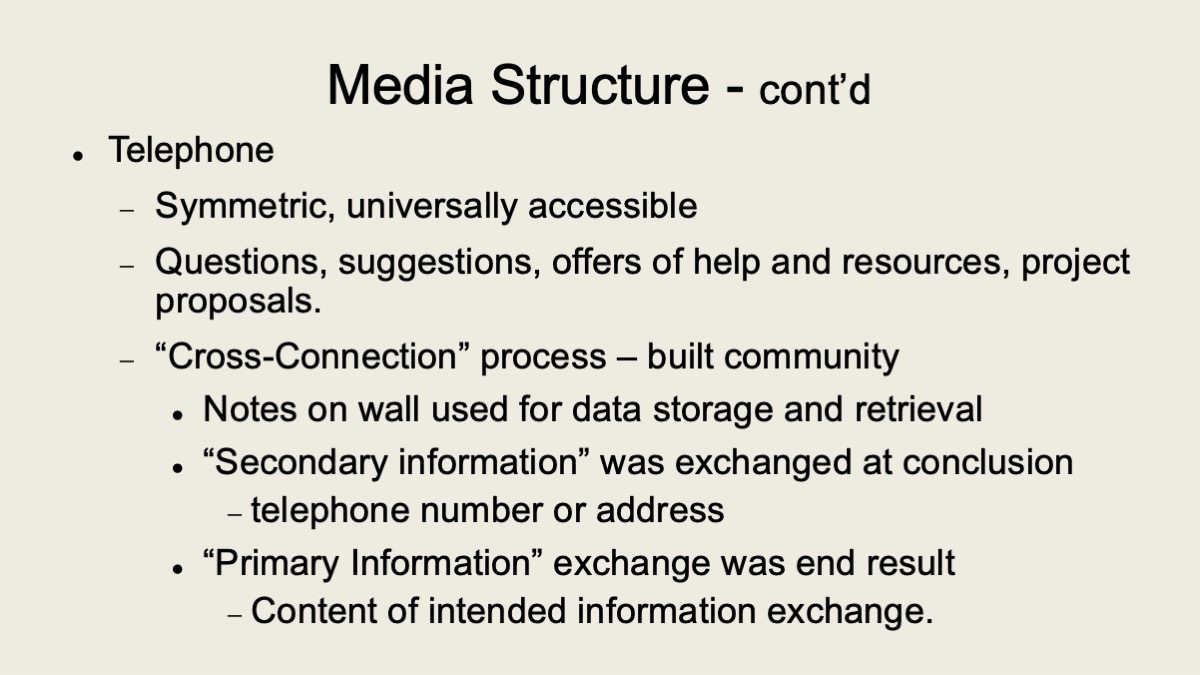
图 5 媒介结构
电话是对称且普遍可用的,至少我们当时是这样的。我在一开始已经讨论过人们(通过电话)提问、给出建议和提供资源。至于这整个过程,我称之为交叉连接(Cross-Connection)。这确实是一个电话技术术语。电话系统中的电线被组织得整整齐齐,直到必须从一组电线交叉连接到另一组电线,就开始混乱了,几乎没有办法做到整洁。所以墙上的纸条是一团糟,但那是交叉连接。这里的情况是,你不能像这样在电话室里进行实质性讨论。他们不得不缩短时间。你可以将信息分为两种形式,即主要信息和次要信息。主要信息是你需要传达的内容,即讲稿、整个故事。次要信息是他们需要联系的人以及如何联系他们,以获取整个故事。因此,电话室交换的是次要信息,而这是有效的。
言论自由运动
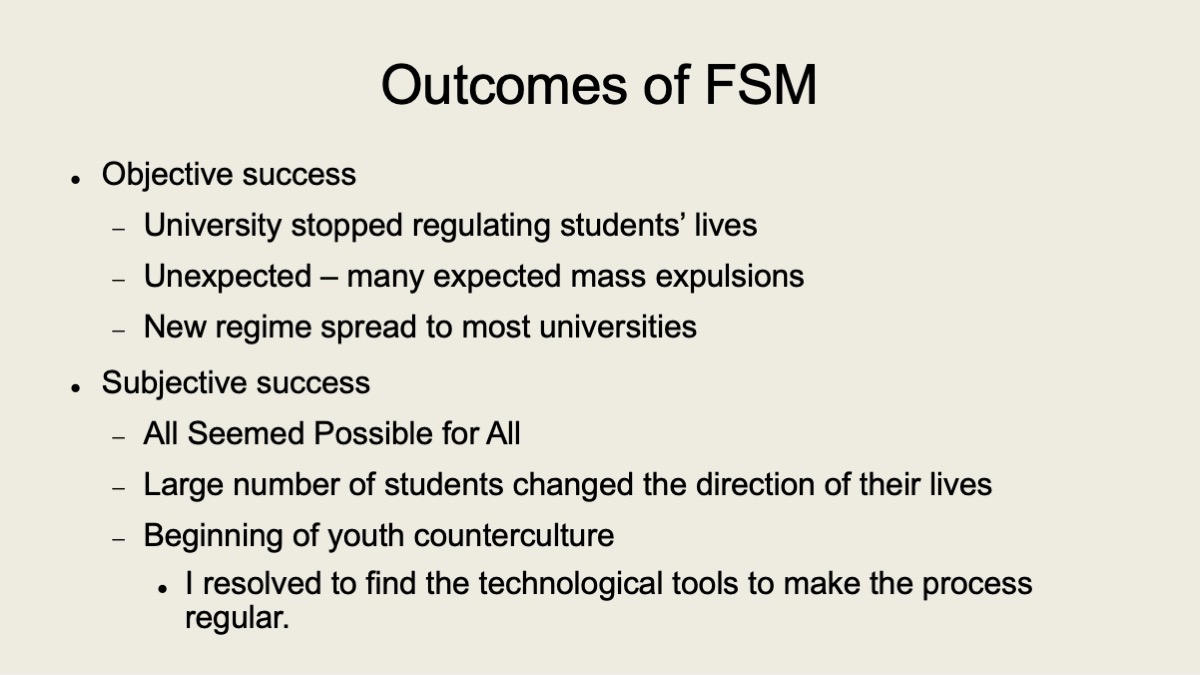
图 6 言论自由运动的成果
我提到,从客观的角度来看我们取得了成功,然后便迎来了 1965 年 1 月的奇迹。几个学生创办了一本令人瞠目结舌的新杂志,也是《滚石》杂志的前身,他们在桌子上悬挂一只巨大的蜘蛛移动装置,以此来做广告 [6]。好吧,他们不得不拆下那个移动装置。我们同意在时间、地点和方式上有规定是可以的。但我们的立场是,“要么言论自由,要么战斗”,即校园内的言论是应受到美国宪法——特别是第一和第十四修正案——的约束。稍后我可以用法律术语来解释,现在不太值得。但如果你有这样一个漂亮口号的时候,你就会有所收获。我提到了人们如何改变他们的生活方向。我也是如此。那是一种神奇的感觉。我希望生活一直都是那样。结果就是要找到技术工具使这个过程规范、合理。但我发现,这将是一项耗费毕生精力的工作。
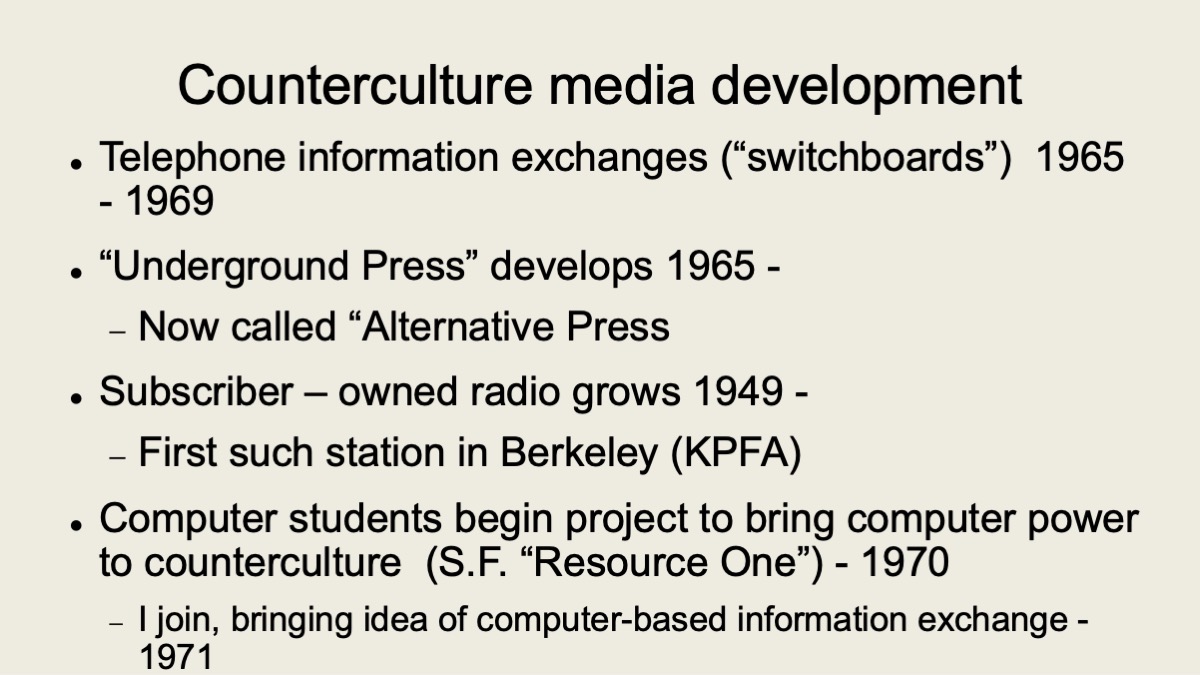
图 7 反文化媒体的发展
电话信息交流在反主流文化中仍在继续。我们过去叫总机。这不是正确的电话术语,但不重要。到了 1969 年,所有的电话总机都被列了出来,原因多种多样。给他们打电话,你就能联系到他们。
我刚才提到的地下刊物从 1965 年开始报道反战示威活动,因为那一年越战愈演愈烈,所以反战活动随之而来,并在言论自由运动的推动下成为可能。现在,它被称为另类刊物,并且仍在继续,没有结束。这些报纸是从家庭和小办公室出版的。我相信它们可以成为社区媒体。所以我投身其中,从事写作。我在那里学到了新闻业的相关知识。我还看到了媒体结构所造成的后果。它们充斥着广告、个人广告、性广告,还有性问题的展示广告。它们为出版商赚了很多钱,但它们不再是社区媒体了。
于是我了解到 KPFA 是一家由和平主义反战抗议者于 1949 年创建的订户拥有的电台,这些人在战争期间曾因反对战争而被监禁,或者被迫做一些政府服务。他们认为媒体需要改变,于是决定设立一家由听众拥有的电台。当时 FM 波段,即频率调制波段,刚刚开始开放。因此,还没有听众。所以他们不得不创造自己的听众。他们需要自己制造收音机并提供给订户。最后也确实做到了。
计算机专业的学生开始了一项计划,将计算机的力量带入反主流文化中。这一点很重要,因为这也是我之后的发展方向。他们成立了一个组织,实际上是接管了一家总机的公司外壳,即旧金山的一家快没落的总机,他们在 1970 年将其成立为“资源一号”(Resource One)。我大约在同一时间听说了他们,而我也在那个时候得出了自己的结论,即我正在寻找的是一个计算机网络。那是在 1970 年。你不能随随便便就去买一台计算机。那可是一件大事。我记得当时我在想:我去哪里弄一台计算机呢?
一年后,我加入了“资源一号”小组。他们获得了一笔长期贷款,实际上是获得了一台大型计算机的捐赠 [7],而且这台计算机正是道格拉斯·恩格尔巴特(Douglas Engelbart)在 1968 年“演示之母”中所使用的机器。在那次演示中,他展示了个人使用(大型主机)计算机的方式。那真是一项天才般的工作。那次演示改变了我对于计算机能做什么以及如何做的看法。
公共广场
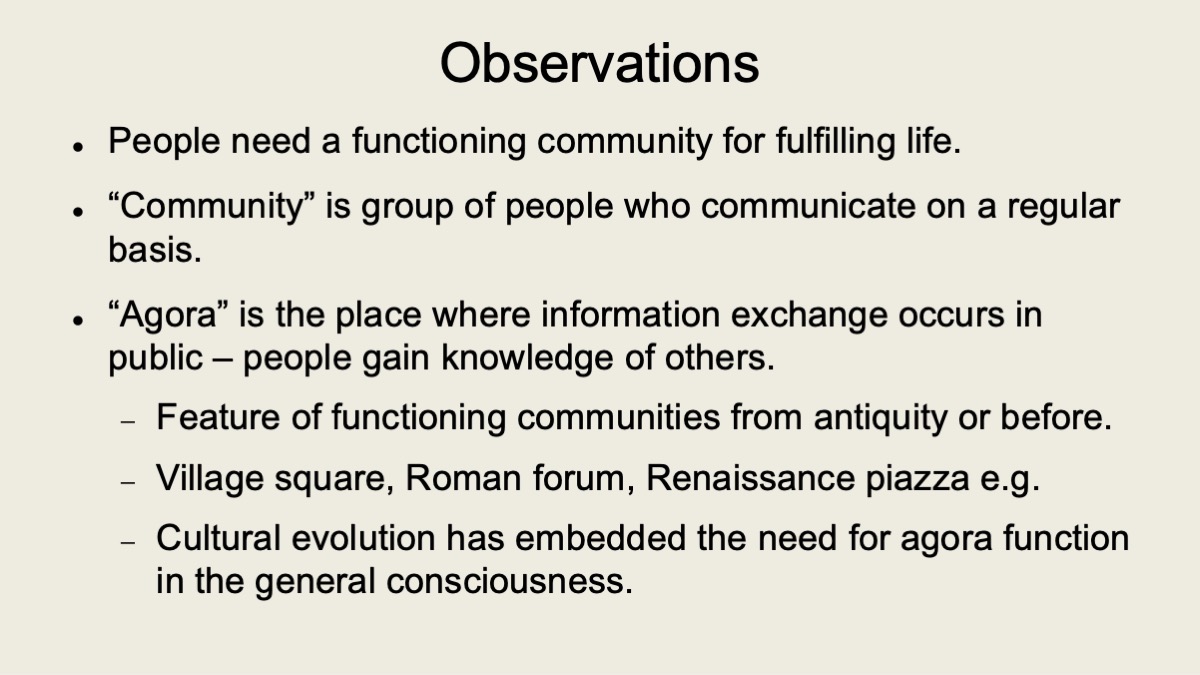
图 8 观察
现在,我想说说我的一些观察,但同样也是值得商榷的。人们需要一个正常运转的社区,才能过上充实的生活。关于人们如何从新石器时代的村落中发展起来,我有一整套的讨论,但现在我不想讨论这个问题。社区可以定义为定期交流的一群人。现在,我要介绍一下“公共广场(agora)”这个词,这不是一个新词,它源自希腊语,即白天大家聚集的场所 [8]。它的名字来源于 “agon”,即摔跤手在相互搏斗时感受到的痛苦。因此,一般来说,公共广场是公开进行信息交流的地方。这一点非常重要。人们可以了解其他人是谁。因此,他们不再是孤立的个体。这就是社区形成的地方。从古至今,我们在每个社区都能看到这一点。有趣的问题是,这是如何发展起来的。我的意思是,比方说,在一个新石器时代的村庄里,文明是在那里发展起来的,但不是在房子里。文明是在房屋之间的空间发展起来的,那就是公共广场。你会发现乡村广场、罗马广场、文艺复兴广场、荷兰平原,它无处不在。文化进化比生物进化更迅速,通过文化进化,对公共广场的需求被内化到我们每个人中。当然这只是我的假设,我还不能说我已经证明了。
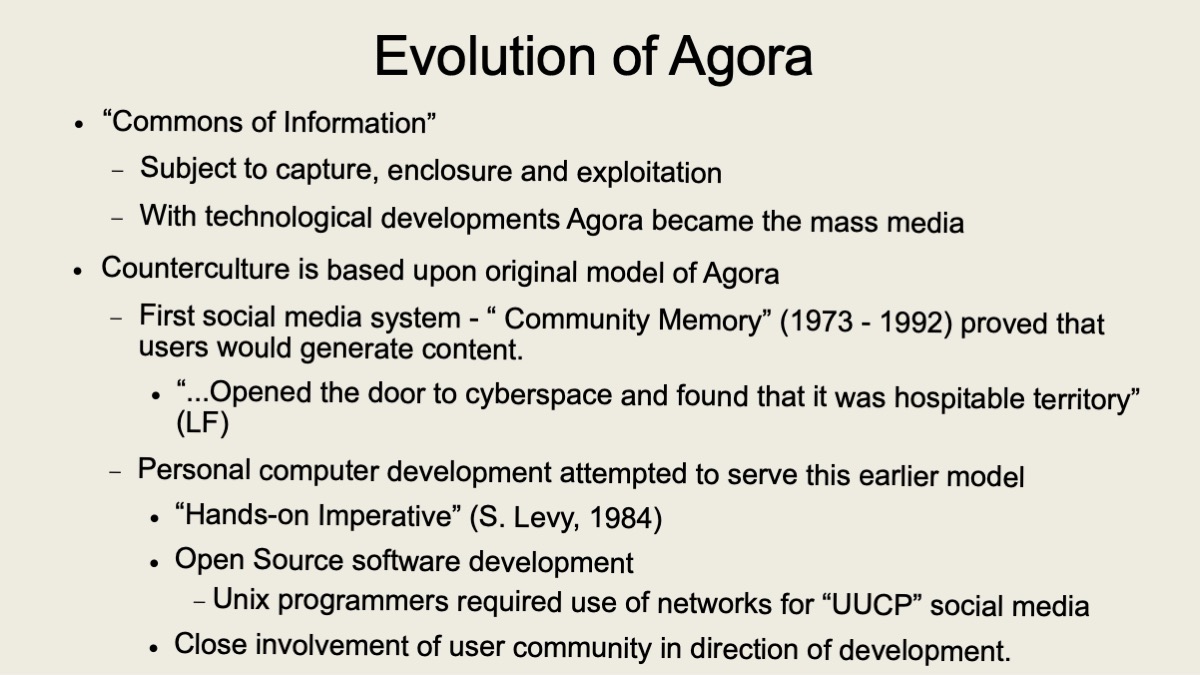
图 9 公共广场的演化
我所指的公共广场也就是信息公地。实际上,我在尝试着给它下定义。就像所有公地一样,它可以被攫取、利用和圈占。英国的农业公地等都受制于此,那也是资本主义的开端。这种情况也发生在公共广场。首先,识字、印刷,人们可以把东西写下来,读给别人和自己听。你必须为此付出点什么,所以它开始私有化。如今,我们的公共广场已经变成了大众传媒,这是一种广播现象。而我所说的公共广场是非广播的,这就是问题所在。同时也正是必须做出改变的地方。
因此,我们建立了第一个社交媒体系统。1973 年,“资源一号”启用。在理查德·格林布拉特(Richard Greenblatt)等黑客的帮助下,我们开发了一个信息检索系统,它不受制于一套预设的索引词。你可以创建自己的索引词。只需要输入就好了。机器负责记账,我们设置了终端,技术上不需要预装数据。我们确实为此做了一些工作。但除此之外,所有的媒体、所有的内容,这些被称为内容的神奇东西,都是由用户自己提供的。我们没有进行广告宣传。我们只是简单地把它放置在一些人们经常光顾的地方。我们必须相当谨慎地选择放置的地点,同时当我们将其迁移时,我们发现其他另一些人会使用它。
它成功了,人们确实使用了它。而我们曾经假设只会有比如工作、住房和汽车的类比,这么猜想的一部分原因是大学的纸贴布告栏被划分为这些类别。但这一设想被打破了,实际上有许多分类,其中包括学习交流对话。我们可以看一下伊凡·伊利奇(Ivan Illich)的著作,在这里提及是因为他对我而言很重要,他在 1970 年或 1971 年写了一本关于去学校化社会的书 [9]。在书的最后,他说:“那我们可以有什么替代学校的东西呢?也许计算机可以用来连接了解某些事情的人和想要学习它们的人”。
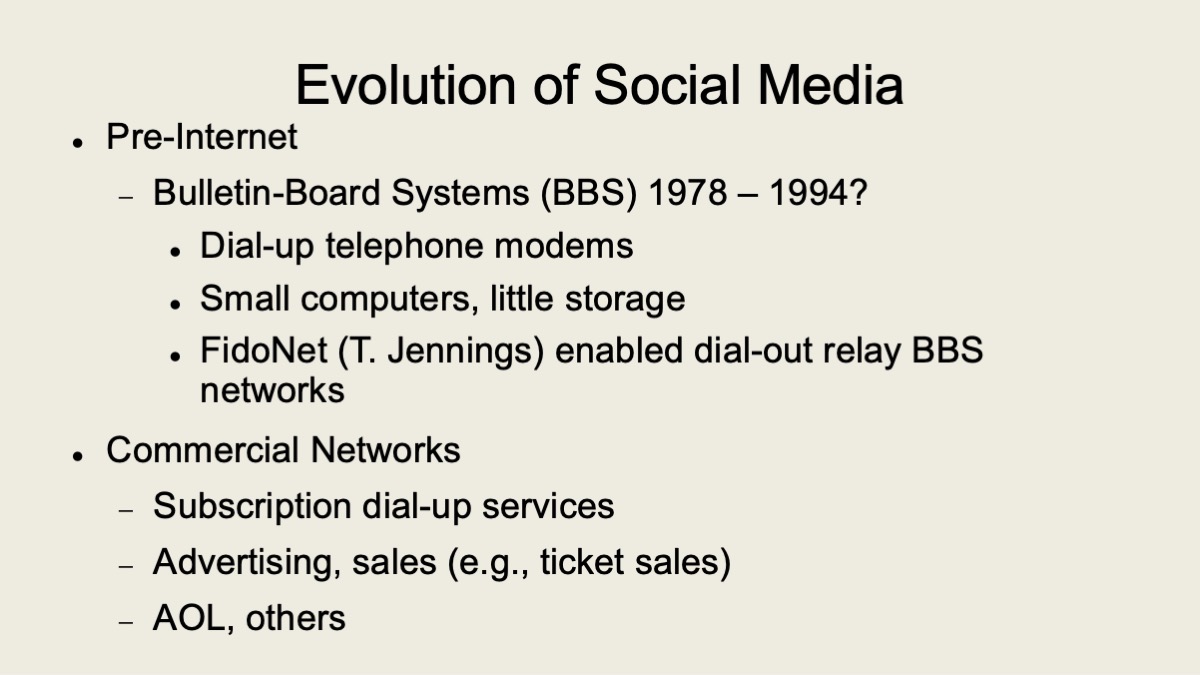
图 10 社交媒体的演化
我们中的有些人在数据库中输入了一个条目,询问在湾区哪里能找到好吃的贝果?我必须解释一下,贝果是一种环形面包卷,烤制的面包卷。我感觉这是中国人的发明,我不太确定。后来它成为了犹太特色,主要分布在东海岸,而在旧金山你很难找到它们。于是有两个答案出现了,其中一个是直接告诉你可以在哪里买到。而另一个答案则脱颖而出,它说,如果你拨打这个电话号码并询问这个名字,一位前贝果制作者会教你如何制作贝果。我们没有弄清他们是否真的这样做了。我想说的是,我们打开了通往网络空间的大门,并发现这是一个热情好客的领域。个人电脑这是在这样的氛围下诞生的。我们需要能在公共场合使用的终端。而我就是硬件工程师。我对软件一窍不通。于是我开始了一项调研,为 1975 年个人电脑的到来做好准备。我们还在其它地方看到社交媒体的发展。例如使用电话的公告板系统以及常见的商业网络,这些我都先跳过不讲。
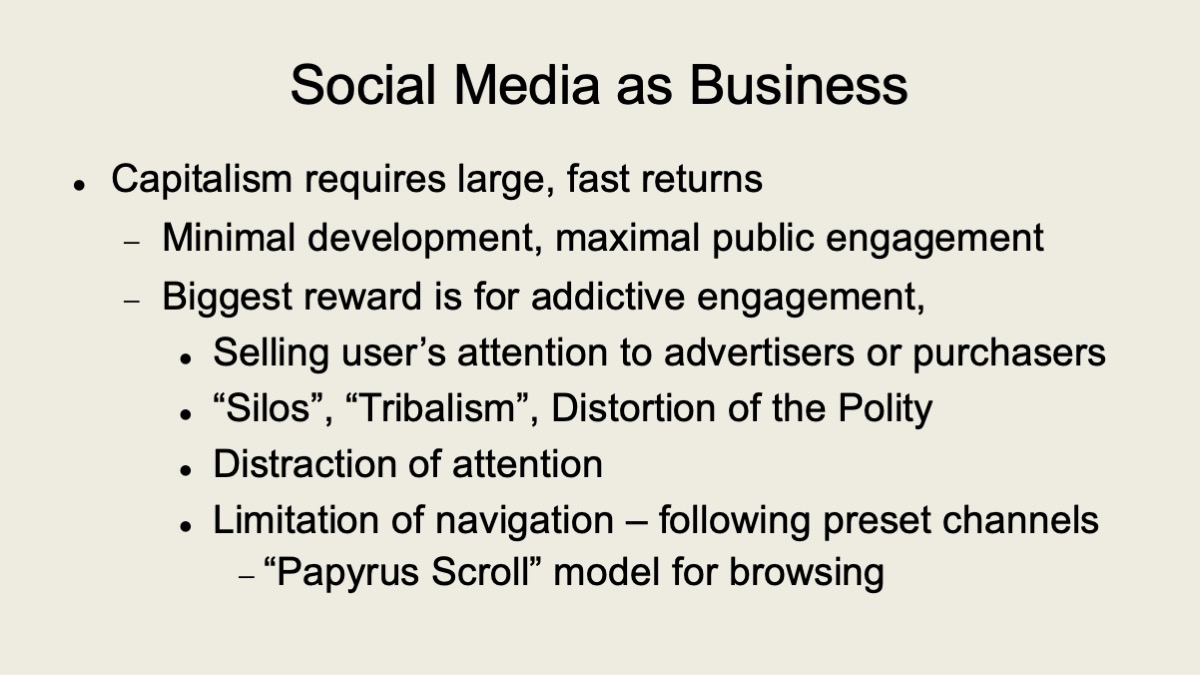
图 11 作为商业的社交媒体
对于之前提及的各个例子,人们都会合理地问,你们做这个赚了多少钱?答案是我们没赚到钱,反而花了钱。对于那些朝着创收的方向发展的人来说,一旦他们赚到钱,他们就停滞发展了。而我们的目标是继续推动这方面的发展。我们今天可以看到,社交媒体已经产生了许多问题。部落化、话语孤岛化、政体扭曲——我的意思是,我们现在在美国正在经历这些——以及注意力分散。大多数社交媒体系统中存储信息的技术模型是纸莎草卷轴。这并没有比埃及人更先进。我可以与任何人私下讨论为什么是这样。
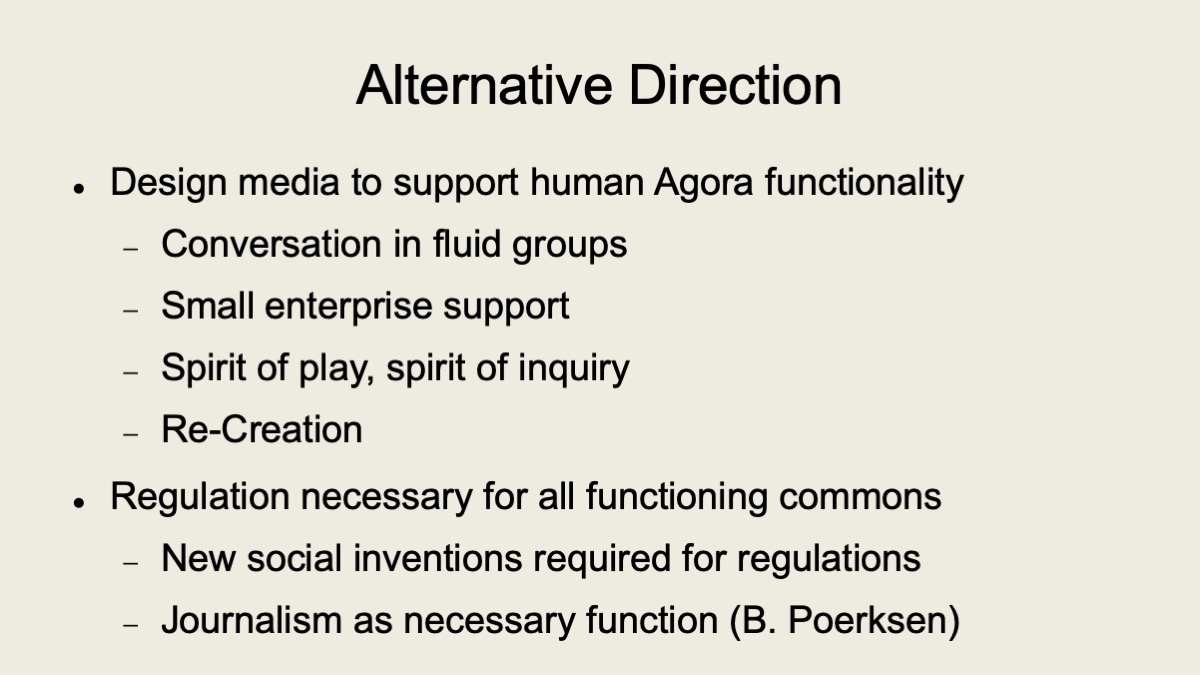
图 12 另类方向
因此,我们需要能够规划出一条替代性的道路。我们还需要研究如何管理信息公地。每个公地都必须要有管理。如果公地要生存下去,它就必须有机地发展。有些人写书说:“哦,公地会有悲剧,因为每个人都会贪婪地追求自己的最大利益”。不,不,那是亚当·斯密(Adam Smith)在说话。那不是像渔业、农业这样的历史性公地,这些公地都有自我管理的程序。我们也需要为信息公地发明自我管理的程序。
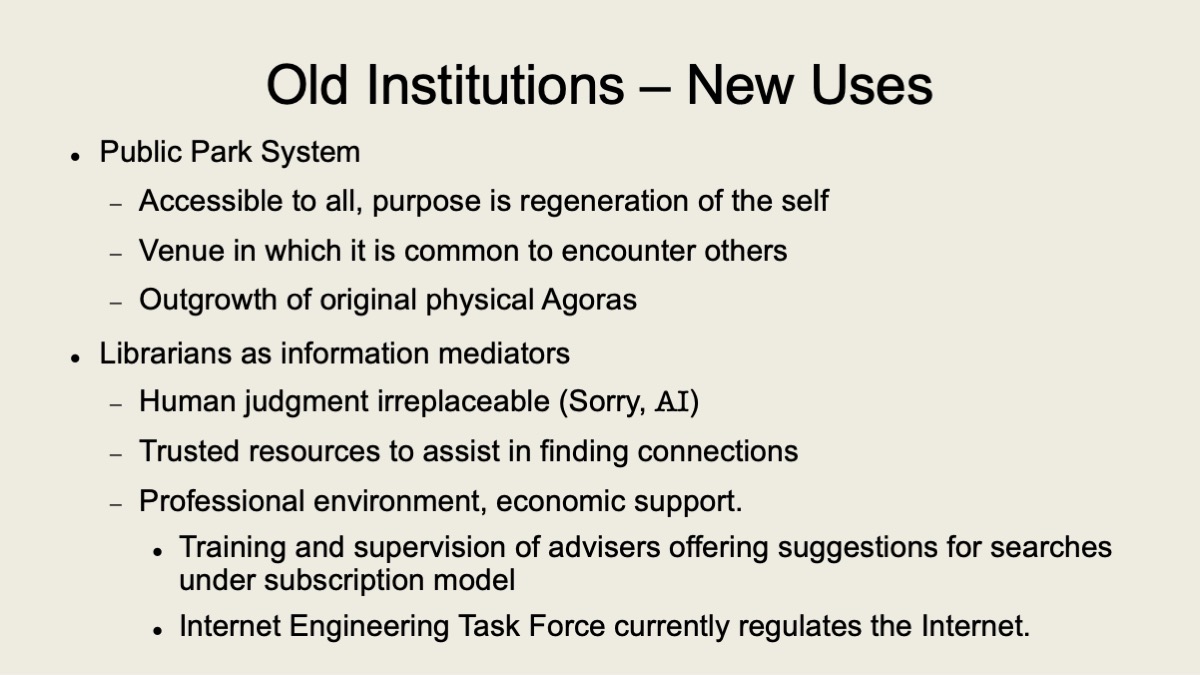
图 13 陈旧机构——新奇用途
有一件事我不知道该怎么说,我认为我们必须有一个叫监察局的东西。这些人有权进行调查,但无权采取任何行动。一位名叫波克森(Porxsen)的德国教授在写一本书《数字狂热》,他联系了我,请我写一篇序言。他说这就是新闻学。这正是我们所缺少的。他是对的,我们需要真正的新闻报道。我建议采用公共公园的模式。人们会说,那公共公园将如何收回成本?如何自给自足呢?它们不需要。但它们发挥了许多凝聚集体的功能。多年来我一直在说,信息公地的天然监护人是图书馆员,或者至少是受过这方面教育的人。还有互联网工程任务组(Internet Engineering Task Force),几十年来一直志愿工作,以保持互联网的正常运行,尽管一直有不同的私人机构试图接管它,但都被成员们拒绝了,因为这是工人的权力。这些都是从事真正工作的工程师。他们不会让别人告诉他们该做什么。
我的演讲已经接近尾声。我会努力继续我的工作,现在有人问我:“你不后悔吗”?我不后悔。我们还有很多工作要做。我认为我们可以通过这种方式指明方向,而这并不是我们今天所说的社交媒体的发展方向。他们会做自己的事情。我对阻止他们不感兴趣。我们也无法阻止他们。我们必须提供自我管理信息公地的结构、文化和实践。我能为此做点什么,我相信你们也可以。谢谢大家。
Q&A 观众问答
问题 1:感谢您精彩的演讲和引人入胜的故事。所以,我想知道,在您看到的现有事物中,哪一种系统或机构最接近您设想的类型?当你说到图书管理员是信息中介,或者是作为公共空间的信息共享中心,人们可以在这里与他人会面时,我立刻想到了公共图书馆。我还想到了科学文献以及科学文献是如何运作的。所以,我想知道是否有特定的在线或离线机构或系统,目前在您看来最接近理想模型。
答:我想我还没有足够的知识来很好地回答这个问题。因为我还没有成为媒介批评家。我批评媒介,是的,但我仍在努力建构一些东西。如果你不太了解竞争对手,他们可能会把你吓跑。所以,对于什么是最接近的,我没有很好的答案。但我邀请大家尝试自己找到适合自己的答案,并进行讨论。这将是最有成效的结果。所以,我不能给出一个明确的答案,说这个最接近,那个不接近。抱歉。
问题 2:感谢您的分享。我的问题可能就像您所说的,应该是我自己深思熟虑的问题。但我一直在思考,例如,对于我们当前的现实,比如中国社会,我了解社会结构与您经历或提供的有所不同。例如,如果今天在公共公园组织活动,作为一种另类方案,与我们在这里可以做的事情相比,是更容易还是有些不同。此外,我一直在思考如果我们今天想要创建一个新的社交媒体结构,就像我们必须将人们从例如微信中迁移到新的结构。而在 20 世纪 60 年代,情况并非如此,因为当时并没有那种结构。所以我不知道您是否对构建不同结构中的技术方面有何想法。因为也许我在技术知识方面缺乏知识,不知道我们是否可以使用任何其它的网络,例如蓝牙等,我不太了解这方面。
答:可能我比较奇怪,我对过去了解很多。我也在尝试着发明未来,但我对现在并不是很了解。首先,公园是一个隐喻。我谈论的是使用相同的组织概念,它们对很多可能提出的异议提供了答案。并不是说我们要字面上地在“公园”里行动。所以让我们明确这一点。我知道中国社会与西方社会有很大的不同。我只在西方社会和中东社会进行了研究,而且不太多。我的大部分教育都来自于我在伯克利的时间,确切来说是 29 年,因为我在那里生活并创业。我们还有许多人类学研究要做。我知道这里有一个很棒的博物馆。我非常期待参观它,开始我的中国文化史教育。
我对发展出意外事物的过程确实有一些经验。这需要一定程度的视野“狭窄”。所以如果你学习各个方面的一切知识,你就会知道所有方法都不可行。因此,你需要限制学习的广度,必须有选择性地学习。你必须基于远见前进。你无法证明自己是对的,但你有这种远见。你能做的最好的事就是去实践、测试、经历并分析。这就是辩证的过程。如果有人来找我要一本关于如何做的书,好吧,其实我将在一年内出版一本书。我已经写好了。它详细介绍了我一直在说的事情以及更多的内容。我希望人们不仅仅把它当作一个有趣的文本来阅读,然后说,看这个疯子,而是说,我在其中看到的某个部分让我考虑到了某些事情。那将是最好的结果。我没有比这更好的建议。买我的书吧!我们将尝试做一个中文版。我会和我的出版商讨论一下。但我想可能需要和你们交流一下这本书的读后感。无论如何,祝愿大家好运。我指望还能再活上 15 年,如果我幸运的话。但 15 年后的李·费尔森斯坦可能不太像现在。我可能只是一个自封的先知,没打算告诉人们该如何做任何事情。没人应该听我的。但与此同时,我确实希望能够创作一些作品,不仅基于我所学知识的新版本社区记忆(Community Memory),这不是最重要的,重要的是每个人的贡献,这是我所期待的。
问题 3:你谈到了卷轴和纸莎草纸卷轴,我们又回到了这个问题上。你是否可以多补充一点。
答:嗯,每台计算机从最早的计算机开始都必须具备一些编辑功能。你有一个信息块,那就是一个文件。你总是能够在文件的末尾添加东西并向下延伸,就像卷轴一样。这就是我们所知道的大多数社交媒体系统开始和结束开发的地方。然而对于社区记忆,我们将其视为一本书。它有一个索引。有趣的部分是读者可以创建索引。并对他们的项目添加索引词等。我们通过三代的开发对此进行了改进。发展成为一种双数据结构,通过超链接的方式,你可以附加你的项目或索引词。或者任何读者都可以添加索引词,无论它们是否出现在不同的地方。我们几乎没有开始在实操中使用它。它只运行了两年。这就是我接下来要开始的地方。
计算机是有能力的,它们可以做我们无法做的事情。否则,目前,如果你要在 Craigslist 中查找,理论上,你会进入一个部分,然后开始阅读该部分的滚动条目。这个滚动非常长,以至于你只能查看一天的信息。因此,每次你将一个项目放到 Craigslist 上,你都必须返回并再次输入以保持其活动状态。于是这个庞大的滚动条不断发展,没有人会阅读到。然后我们有 Slack 和 Discord,这是为游戏玩家设计的,为过度摄入咖啡因青少年设计的,他们只想有一个地方可以写点东西,让人们看到它,然后它就会无限滚动,永远不会有被看到的第二次机会。因此,你可以看到结构本身就有其内置的用途。因此,我们更感兴趣的是拥有索引并能够创建对话。从我看来,这才是社交媒体的基本单位。事实上,我们希望不久后在这里做一个实验,允许人们在物理空间中这样做,并记录下结果。我当然希望我的观点是正确的。但如果不是,我将继续改进。
问题 4:在二十世纪六十年代的运动中,我们发现,即使是主修社会科学或具有技术和工程背景的学生,他们的主动性也非常强。他们在采取主动时非常积极。你可以看到,他们的心态发生了变化。心态的变化也会带来强有力的行动。但如今,那些主修技术和工程背景的学生正在失去采取行动的动机。那么,社会科学专业的学生又如何能有动力去学习更多的技术背景知识,从而促进自己的研究呢?
答:我能建议的最好办法就是在不同的部落之间进行对话,我们是否可以称它们为部落?我不知道,我不喜欢这样。但事实上,社交媒体可以为此提供便利。尽管如此,重要的对话还是在个人讨论中进行。我想,房间里最大的问题总是:我怎样才能靠这个赚大钱?我们可以从这样一个角度出发:你不会在这个媒介上赚大钱,但人们可以通过它扩大自己在世界上的机会。很久以前广播里有一个笑话。有人说他们家要装中央供暖系统,所以要把暖气片放在外面。正直的人说,这是为什么呢?他说,如果外面暖和,里面也会暖和。这应该是我们的想法。我们要让外面暖和,里面才会暖和。这就带来了一个文化问题,如何让人们接受这些信息。我不知道你是如何做的,但我明白。讨论和对话,尤其是一对一的讨论和对话,是必须的。因此,你需要创建一个论坛,让这些对话得以进行。很抱歉,我不能说得更详细。每当我遇到一个问题,我都会制定一个计划。工程师都是这么做的,而我对此没有计划。但你也可以这样做,好吗?
问题 5:您认为如今的联邦制社交媒体(如 Mastodon)能解决社交媒体商业化的问题吗?谢谢。
答:首先,我不了解 Mastodon。我只是听说过,所以我不能给你一个明智的答案。为一个目的开发的东西能用于另一个目的吗?也许吧,如果幸运的话。但你可能必须以不同的方式使用它。这就是文化转型。这就是它的工作原理。他们本不想这么用,但每个人都在这么用。所以,他们要么跟风,要么就为自己能赚到钱而高兴。但这个方向并不是注定的。所以,Mastodon 是有目的的,我甚至不知道是什么。用户必须把它的目的变成自己的目的,而不是相反。他们必须发展实践、神话、文学,并且能够用这种语言描述他们正在做的事情,使用以前从未使用过的词汇和术语。文化挪用,我想就是这个词。是时候进行文化挪用了吧?所以我不能直接回答 Mastodon 本身,但总的来说,这就是我们需要的。
编译:蔡泽锐
注释
[1] 言论自由运动(Free Speech Movement)是 1964-65 年由美国加州大学伯克利分校(The University of California, Berkeley)学生领导的一场争取学生及公民言论自由、学术自由和政治自由的民权运动。可参见李·费尔森斯坦于 1998 年创建的自由言论运动档案馆 ( https://www.fsm-a.org ) 。
[2] 指的是 Franco Bifo Berardi 的演讲,参见 https://www.caa-ins.org/archives/11757 。
[3] 1962 年,密西西比州只有 5.3% 的非裔美国人登记投票。自由之夏是 1964 年 6 月由联合组织理事会(Council of Federated Organizations)策划的美国志愿活动,目标是推广密西西比的非裔美国人的投票登记。这些非洲裔美国人由于选民登记及其他法例的限制,一直无法获得投票权。计划参与者包括密西西比黑人以及超过一千名来自另一个州的白人。活动其间,参与者受到三 K 党、警方、州政府及当地政府的暴力袭击,包括欧打、纵火、非法拘捕。三名参与者遭到谋杀。这个计划同时也在密西西比的小镇设立许多自由学校、自由之家以及社区中心,以帮助当地的黑人。
[4] 1964 年,在美国反越战和非裔美国人民权运动等大背景下,加州大学伯克利分校的一些学生开始在校园内开展相关宣传、筹款等政治活动。1964 年 9 月,学校教务长 Katherine Towle 宣布禁止在校园内进行非学校性政治活动(off-campus political activities),引发学生不满。
[5] 海特·阿什伯利区是美国 60 年代嬉皮士文化的发源地。其为 60 年代爱之夏 (Summer of Love)、权力归花 (Flower power) 等社会运动,以及死之华乐团(Grateful Dead)的发源地,如今仍是旧金山拥有丰富历史的知名景点。
[6] 蜘蛛(Spider)是性、政治、药物和摇滚(Sex, Politics, Drugs and Rock-and-Roll)的扩展缩写。
[7] 这笔经费,来自《全球概览》停刊的”发钱派对”。
[8] 阿哥拉(古希腊语:ἀγορά)是古希腊城邦的中心公共空间,节日、聚会和市集所在地。
[9] Ivan Illich. (2000). Deschooling Society (New edition). Marion Boyars Publishers Ltd.
第八届网络社会年会发言稿

图 1 Lee Felsenstein 演讲现场图
谢谢。首先,我必须解释一下,我不是学者,我是一名工程师。因此,我不会试图去做一些基于事实的断言。我将会提出一些说法,并邀请每个人根据实际情况来检验这些说法。因为在工程领域,你总是在工具不完善、信息不充分的情况下工作,而且还必须产出一个能够满足必要功能的结果。而这始终是一个猜想的过程。因此,我邀请大家在此基础上对我和我的论断进行评判。
现在我们看到的这张照片(图 2),我把它称为社交互联网的起点。1964 年,我在伯克利的言论自由运动(Free Speech Movement)办公室违规拍摄了这张照片 [1]。现在这个场景看起来并不那么计算机化,因为在那个时候还没有计算机,只有电话。它看起来也不是很整洁,效率也不高。但是在这种低效中,我认为产生了一个至今仍在发挥作用的结果。我们可以(在图片中)看到人们正在忙着接听电话。那个时候只有两部电话。墙上的物品构成了一个数据库,随着人们的电话呼叫而不断变化。今天,在一家管理良好的公司里,电话室会井然有序,发送出去的信息或传输进来的信息,会被记录、分类整理,并传递给必要人员,信息双向流动,一切都条理分明,因为商业运作依赖于这一点。

图 2 言论自由运动中心的电话室
这里发生的情况与此不同。人们以各种原因打电话过来。有时他们想要传达信息。有时他们需要解答问题。有时他们想提供资源。我记得在其中一份布告中,有人提供免费理发。因为那时候我们正迎来一个假期,人们回家见父母之前通常都需要理发。而且他们还为它取了个名字,叫做理发中心。当时我们有一个做法就是给所有事物都加上“中心”。这里(图 2)是在言论自由运动中心内。通过这组电话、桌子和这些人,各种联系都在建立。可以想到,你不能随便地让人进到办公室。信息不仅仅存在于人们的头脑中,也展示在墙上。之所以说这对 1964 年和未来都很重要,是因为它是校园社区形成机制的一部分。伯克利是一个很大的地方。在那个年代,伯克利大学有 2 万名学生。今天则有 3 万了。当时它因人际关系疏离而臭名昭著。当你来到学校,在熙攘的人群中,你是孤独的。你不认识任何人,其他人也不认识你,也不在乎你。当我到了伯克利大学的时候,我其实很喜欢那种氛围,但我是个特例。

图 3 反文化到社交媒体
和我们昨天从意大利教授那里听到的情况相反 [2],自由言论运动所围绕的问题是,在当时民权运动正在向北方拓展的背景下,大学行政管理部门想要压制学生们组织支持运动的能力。事实上,1964 是一个特别的年份,因为在 1964 年夏天,自由之夏(Freedom Summer Project)吸引了来自全国各地的学生,他们尝到了密西西比和阿拉巴马州普遍存在的恐怖主义 [3]。之后有一些学生返回了,有一些没有。返回的这些人就好像是从战场回来的老兵一样。我还记得那种感觉。不是说我有这种感觉,而是那些人身上有,你能明显地感受到。
当时,学校颁布了一项新规定 [4]。这些学生团体在校园外摆起了桌子。人行道上有一面海报墙。成千上万的人在进出校园的路上蜂拥而过,他们可以在这些桌子上获取信息,捐款,还可以报名参加各种活动,包括当年在旧金山共和党全国大会长廊中举行的示威活动。当然,这背后也是 MAGA (Make America Great Again)运动先驱的巴里·戈德华特(Barry Goldwater) 和一个名叫斯克兰顿(Scranton)的温和派之间的争论。当地的政治领袖站在 MAGA 一方,他对学生在这些桌子上被招募到旧金山去参加大会,并抗议他的候选人感到不满。我们理解,我们没有确凿的证据表明他和其他人对管理层施加了压力,因为当时还在抗议就业歧视,有一些静坐示威,局势相当混乱。
因此,大学正面临来自外部的压力。他们发布了这项规定。但那完全是错误的时机,再次强调,因为公民权问题并不遥远,不仅存在于南方,而且已经直接逼到我们的门口了。从“自由之夏”回来的学生们都深度参与其中。因此,所有学生组织,无论是从极左到极右,从被摧毁的进步劳动党(Progressive Labor Party)到自由主义者。后者是类似个人主义者协会(Society of Individualists)之类的组织,他们的政治立场属于校园中的右翼,包括年轻的共和党人和加州政治行动保守派(Cal Conservatives for Political Action)。他们都团结在一起,形成统一战线来面对这个问题并进行抗争。而由于大学发现他们实际上拥有靠近路缘的人行道上的土地,我们无法将桌子搬出去。因此,桌子必须搬进校园内。我们采取了经典的公民不服从策略,即“填满监狱”。
我们在行政大楼前摆了桌子。如果在校园的任何地方都会被视为非法,那么这里是一个不错的地方。院长们会出来登记学生的名字以便进行处分。一旦他们登记了一个人的名字,另一个人就会站出来,包括我也被登记了。最终,在那一天,当学生被叫到院长办公室时,有 150 名学生出席。学校领导想要惩罚我们,但没能做到。第二天,也就是 1964 年 10 月 1 日,抗议活动继续进行。第一个非学生被指控。这对学校来说是一个幸灾乐祸的机会,因为去年通过的一项法律规定,任何未注册的学生或教职员工进入校园都将受到刑事处罚。他们抓到一个,也因此做了可能最愚蠢的事情。中午的时候,就在人群即将涌入的前不久,他们开来了一辆警车,然后把这个人,杰克·温伯格(Jack Weinberg)抓进了警车。你能想到接下来发生了什么吗?所有人都开始坐下,把警车包围住。事态越来越严重,一直持续了 32 个小时。最终双方谈判,达成了协议。
我们持续了两个月,直到最后在学校大楼进行了一场高潮迭起的静坐示威。我参与其中,当时有 784 名学生被捕。教职员工震惊了,他们认识到了局势的严重性。几天后,在他们的教师联盟中,以 80% 的支持比例投票支持学生的立场。这为获得政治支持提供了基础,导致大学的所有者,即董事会,做出让步并表示不会干预这件事了。因此,突然之间,校园对于任何类型的学生活动都持开放态度,无论是否经过大学的批准。在此之前,除非经过批准,否则你不能在校园里发传单。而现在你可以分发任何东西。
媒介结构

图 4 媒介结构
我想在这里谈一谈媒介结构的问题,因为这引起了我的思考。不是说它让我现在开始思考这个问题,而是从 1964 年开始我就已经在思考这个问题了。当时我是工程系的学生。我坚持一种观点,一种模糊的左翼观点,认为我未来的任务将是自动化和取代劳动力,这将在某种程度上推动社会进步。因为我没有课上,也没有作业,所以我就想去言论自由运动办公室工作。在那六个月的时间里,我一直在校园里工作。我的目标是找出作为一名技术专家我所能做的事情,因为这就是我认为我所能做的一切。我无法改变人们的思想,但我可以制造东西。我稍后会讲到那时候发生的事情。总之结果就是我走上了一条探索之路,试图找到哪些媒介技术是有效的。之所以这样说,是因为 1965 年 1 月,12 月是学年的最后一个月。当时的校园非常热闹。各种各样的人在不同领域里创作。这是我们没有预料到的。这是反文化的开端,尤其是在旧金山湾区。过去也有过反文化,但我们这里讨论的是 20 世纪 60 年代的反文化。我写了些小文章,有人发表了。当然,年轻的工科学生一般不会这么做,我们通常都保持沉默。但人们不再保持沉默,也不再待在一个地方。事实上,当时估计有数千名学生辍学,离开了大学,出现在海特阿什伯利之类的地方 [5]。他们形成了自己的社区。这是一切的关键。
我想在这里回顾一下媒介结构。在那前后不久,我对媒介进行了分析,将其分为两类:广播媒介和非广播媒介。广播媒介由单人向多人传播相同的信息。可以是印刷品,不一定非得是电磁传播。它可以在午间集会上进行。我们几乎每天都有午间集会。成千上万的人们会听到关于当前危机的消息。我们分发传单。我也帮忙制作了些传单,那是我能做的事情之一。人们早上来到校园,拿着我们分发的传单。他们冒着违纪的风险走出去分发。大家都知道(分发未经大学批准的出版物违反了学生行为规则)。每个人都成了讨论的焦点。人们会走过来问他们,你们为什么要这么做?发生了什么事?你们怎么看?我们在伯克利还有一个订户所拥有的广播电台,我认为这推动了整个进程,因为我们有了一种反馈循环。我们可以把信息传递到那个电台。它是非商业性的,由像我们这样的人运营着。
非广播媒介是围绕着传单发放者展开的讨论。我们建立了一个组织结构,有一个庞大的执行委员会,实际上它并不是执行性质的,但它有来自所有生活组织和其他组织的代表。这提供了一个双向信息通道。这些人参与制定政策,还有一个由他们选举产生的指导委员会,负责处理日常决策。在斗争过程中,实际上有一些指导委员会成员被替换,这在革命组织中有点不寻常。但我们建立了一条和所有选民保持联系的途径。我们还有在学生娱乐中心和艺术工作室工作的人。他们在那里进行讨论。我们利用电话系统进行信息交流。这也算作非广播媒介。

图 5 媒介结构
电话是对称且普遍可用的,至少我们当时是这样的。我在一开始已经讨论过人们(通过电话)提问、给出建议和提供资源。至于这整个过程,我称之为交叉连接(Cross-Connection)。这确实是一个电话技术术语。电话系统中的电线被组织得整整齐齐,直到必须从一组电线交叉连接到另一组电线,就开始混乱了,几乎没有办法做到整洁。所以墙上的纸条是一团糟,但那是交叉连接。这里的情况是,你不能像这样在电话室里进行实质性讨论。他们不得不缩短时间。你可以将信息分为两种形式,即主要信息和次要信息。主要信息是你需要传达的内容,即讲稿、整个故事。次要信息是他们需要联系的人以及如何联系他们,以获取整个故事。因此,电话室交换的是次要信息,而这是有效的。
言论自由运动

图 6 言论自由运动的成果
我提到,从客观的角度来看我们取得了成功,然后便迎来了 1965 年 1 月的奇迹。几个学生创办了一本令人瞠目结舌的新杂志,也是《滚石》杂志的前身,他们在桌子上悬挂一只巨大的蜘蛛移动装置,以此来做广告 [6]。好吧,他们不得不拆下那个移动装置。我们同意在时间、地点和方式上有规定是可以的。但我们的立场是,“要么言论自由,要么战斗”,即校园内的言论是应受到美国宪法——特别是第一和第十四修正案——的约束。稍后我可以用法律术语来解释,现在不太值得。但如果你有这样一个漂亮口号的时候,你就会有所收获。我提到了人们如何改变他们的生活方向。我也是如此。那是一种神奇的感觉。我希望生活一直都是那样。结果就是要找到技术工具使这个过程规范、合理。但我发现,这将是一项耗费毕生精力的工作。

图 7 反文化媒体的发展
电话信息交流在反主流文化中仍在继续。我们过去叫总机。这不是正确的电话术语,但不重要。到了 1969 年,所有的电话总机都被列了出来,原因多种多样。给他们打电话,你就能联系到他们。
我刚才提到的地下刊物从 1965 年开始报道反战示威活动,因为那一年越战愈演愈烈,所以反战活动随之而来,并在言论自由运动的推动下成为可能。现在,它被称为另类刊物,并且仍在继续,没有结束。这些报纸是从家庭和小办公室出版的。我相信它们可以成为社区媒体。所以我投身其中,从事写作。我在那里学到了新闻业的相关知识。我还看到了媒体结构所造成的后果。它们充斥着广告、个人广告、性广告,还有性问题的展示广告。它们为出版商赚了很多钱,但它们不再是社区媒体了。
于是我了解到 KPFA 是一家由和平主义反战抗议者于 1949 年创建的订户拥有的电台,这些人在战争期间曾因反对战争而被监禁,或者被迫做一些政府服务。他们认为媒体需要改变,于是决定设立一家由听众拥有的电台。当时 FM 波段,即频率调制波段,刚刚开始开放。因此,还没有听众。所以他们不得不创造自己的听众。他们需要自己制造收音机并提供给订户。最后也确实做到了。
计算机专业的学生开始了一项计划,将计算机的力量带入反主流文化中。这一点很重要,因为这也是我之后的发展方向。他们成立了一个组织,实际上是接管了一家总机的公司外壳,即旧金山的一家快没落的总机,他们在 1970 年将其成立为“资源一号”(Resource One)。我大约在同一时间听说了他们,而我也在那个时候得出了自己的结论,即我正在寻找的是一个计算机网络。那是在 1970 年。你不能随随便便就去买一台计算机。那可是一件大事。我记得当时我在想:我去哪里弄一台计算机呢?
一年后,我加入了“资源一号”小组。他们获得了一笔长期贷款,实际上是获得了一台大型计算机的捐赠 [7],而且这台计算机正是道格拉斯·恩格尔巴特(Douglas Engelbart)在 1968 年“演示之母”中所使用的机器。在那次演示中,他展示了个人使用(大型主机)计算机的方式。那真是一项天才般的工作。那次演示改变了我对于计算机能做什么以及如何做的看法。
公共广场

图 8 观察
现在,我想说说我的一些观察,但同样也是值得商榷的。人们需要一个正常运转的社区,才能过上充实的生活。关于人们如何从新石器时代的村落中发展起来,我有一整套的讨论,但现在我不想讨论这个问题。社区可以定义为定期交流的一群人。现在,我要介绍一下“公共广场(agora)”这个词,这不是一个新词,它源自希腊语,即白天大家聚集的场所 [8]。它的名字来源于 “agon”,即摔跤手在相互搏斗时感受到的痛苦。因此,一般来说,公共广场是公开进行信息交流的地方。这一点非常重要。人们可以了解其他人是谁。因此,他们不再是孤立的个体。这就是社区形成的地方。从古至今,我们在每个社区都能看到这一点。有趣的问题是,这是如何发展起来的。我的意思是,比方说,在一个新石器时代的村庄里,文明是在那里发展起来的,但不是在房子里。文明是在房屋之间的空间发展起来的,那就是公共广场。你会发现乡村广场、罗马广场、文艺复兴广场、荷兰平原,它无处不在。文化进化比生物进化更迅速,通过文化进化,对公共广场的需求被内化到我们每个人中。当然这只是我的假设,我还不能说我已经证明了。

图 9 公共广场的演化
我所指的公共广场也就是信息公地。实际上,我在尝试着给它下定义。就像所有公地一样,它可以被攫取、利用和圈占。英国的农业公地等都受制于此,那也是资本主义的开端。这种情况也发生在公共广场。首先,识字、印刷,人们可以把东西写下来,读给别人和自己听。你必须为此付出点什么,所以它开始私有化。如今,我们的公共广场已经变成了大众传媒,这是一种广播现象。而我所说的公共广场是非广播的,这就是问题所在。同时也正是必须做出改变的地方。
因此,我们建立了第一个社交媒体系统。1973 年,“资源一号”启用。在理查德·格林布拉特(Richard Greenblatt)等黑客的帮助下,我们开发了一个信息检索系统,它不受制于一套预设的索引词。你可以创建自己的索引词。只需要输入就好了。机器负责记账,我们设置了终端,技术上不需要预装数据。我们确实为此做了一些工作。但除此之外,所有的媒体、所有的内容,这些被称为内容的神奇东西,都是由用户自己提供的。我们没有进行广告宣传。我们只是简单地把它放置在一些人们经常光顾的地方。我们必须相当谨慎地选择放置的地点,同时当我们将其迁移时,我们发现其他另一些人会使用它。
它成功了,人们确实使用了它。而我们曾经假设只会有比如工作、住房和汽车的类比,这么猜想的一部分原因是大学的纸贴布告栏被划分为这些类别。但这一设想被打破了,实际上有许多分类,其中包括学习交流对话。我们可以看一下伊凡·伊利奇(Ivan Illich)的著作,在这里提及是因为他对我而言很重要,他在 1970 年或 1971 年写了一本关于去学校化社会的书 [9]。在书的最后,他说:“那我们可以有什么替代学校的东西呢?也许计算机可以用来连接了解某些事情的人和想要学习它们的人”。

图 10 社交媒体的演化
我们中的有些人在数据库中输入了一个条目,询问在湾区哪里能找到好吃的贝果?我必须解释一下,贝果是一种环形面包卷,烤制的面包卷。我感觉这是中国人的发明,我不太确定。后来它成为了犹太特色,主要分布在东海岸,而在旧金山你很难找到它们。于是有两个答案出现了,其中一个是直接告诉你可以在哪里买到。而另一个答案则脱颖而出,它说,如果你拨打这个电话号码并询问这个名字,一位前贝果制作者会教你如何制作贝果。我们没有弄清他们是否真的这样做了。我想说的是,我们打开了通往网络空间的大门,并发现这是一个热情好客的领域。个人电脑这是在这样的氛围下诞生的。我们需要能在公共场合使用的终端。而我就是硬件工程师。我对软件一窍不通。于是我开始了一项调研,为 1975 年个人电脑的到来做好准备。我们还在其它地方看到社交媒体的发展。例如使用电话的公告板系统以及常见的商业网络,这些我都先跳过不讲。

图 11 作为商业的社交媒体
对于之前提及的各个例子,人们都会合理地问,你们做这个赚了多少钱?答案是我们没赚到钱,反而花了钱。对于那些朝着创收的方向发展的人来说,一旦他们赚到钱,他们就停滞发展了。而我们的目标是继续推动这方面的发展。我们今天可以看到,社交媒体已经产生了许多问题。部落化、话语孤岛化、政体扭曲——我的意思是,我们现在在美国正在经历这些——以及注意力分散。大多数社交媒体系统中存储信息的技术模型是纸莎草卷轴。这并没有比埃及人更先进。我可以与任何人私下讨论为什么是这样。

图 12 另类方向
因此,我们需要能够规划出一条替代性的道路。我们还需要研究如何管理信息公地。每个公地都必须要有管理。如果公地要生存下去,它就必须有机地发展。有些人写书说:“哦,公地会有悲剧,因为每个人都会贪婪地追求自己的最大利益”。不,不,那是亚当·斯密(Adam Smith)在说话。那不是像渔业、农业这样的历史性公地,这些公地都有自我管理的程序。我们也需要为信息公地发明自我管理的程序。

图 13 陈旧机构——新奇用途
有一件事我不知道该怎么说,我认为我们必须有一个叫监察局的东西。这些人有权进行调查,但无权采取任何行动。一位名叫波克森(Porxsen)的德国教授在写一本书《数字狂热》,他联系了我,请我写一篇序言。他说这就是新闻学。这正是我们所缺少的。他是对的,我们需要真正的新闻报道。我建议采用公共公园的模式。人们会说,那公共公园将如何收回成本?如何自给自足呢?它们不需要。但它们发挥了许多凝聚集体的功能。多年来我一直在说,信息公地的天然监护人是图书馆员,或者至少是受过这方面教育的人。还有互联网工程任务组(Internet Engineering Task Force),几十年来一直志愿工作,以保持互联网的正常运行,尽管一直有不同的私人机构试图接管它,但都被成员们拒绝了,因为这是工人的权力。这些都是从事真正工作的工程师。他们不会让别人告诉他们该做什么。
我的演讲已经接近尾声。我会努力继续我的工作,现在有人问我:“你不后悔吗”?我不后悔。我们还有很多工作要做。我认为我们可以通过这种方式指明方向,而这并不是我们今天所说的社交媒体的发展方向。他们会做自己的事情。我对阻止他们不感兴趣。我们也无法阻止他们。我们必须提供自我管理信息公地的结构、文化和实践。我能为此做点什么,我相信你们也可以。谢谢大家。
Q&A 观众问答
问题 1:感谢您精彩的演讲和引人入胜的故事。所以,我想知道,在您看到的现有事物中,哪一种系统或机构最接近您设想的类型?当你说到图书管理员是信息中介,或者是作为公共空间的信息共享中心,人们可以在这里与他人会面时,我立刻想到了公共图书馆。我还想到了科学文献以及科学文献是如何运作的。所以,我想知道是否有特定的在线或离线机构或系统,目前在您看来最接近理想模型。
答:我想我还没有足够的知识来很好地回答这个问题。因为我还没有成为媒介批评家。我批评媒介,是的,但我仍在努力建构一些东西。如果你不太了解竞争对手,他们可能会把你吓跑。所以,对于什么是最接近的,我没有很好的答案。但我邀请大家尝试自己找到适合自己的答案,并进行讨论。这将是最有成效的结果。所以,我不能给出一个明确的答案,说这个最接近,那个不接近。抱歉。
问题 2:感谢您的分享。我的问题可能就像您所说的,应该是我自己深思熟虑的问题。但我一直在思考,例如,对于我们当前的现实,比如中国社会,我了解社会结构与您经历或提供的有所不同。例如,如果今天在公共公园组织活动,作为一种另类方案,与我们在这里可以做的事情相比,是更容易还是有些不同。此外,我一直在思考如果我们今天想要创建一个新的社交媒体结构,就像我们必须将人们从例如微信中迁移到新的结构。而在 20 世纪 60 年代,情况并非如此,因为当时并没有那种结构。所以我不知道您是否对构建不同结构中的技术方面有何想法。因为也许我在技术知识方面缺乏知识,不知道我们是否可以使用任何其它的网络,例如蓝牙等,我不太了解这方面。
答:可能我比较奇怪,我对过去了解很多。我也在尝试着发明未来,但我对现在并不是很了解。首先,公园是一个隐喻。我谈论的是使用相同的组织概念,它们对很多可能提出的异议提供了答案。并不是说我们要字面上地在“公园”里行动。所以让我们明确这一点。我知道中国社会与西方社会有很大的不同。我只在西方社会和中东社会进行了研究,而且不太多。我的大部分教育都来自于我在伯克利的时间,确切来说是 29 年,因为我在那里生活并创业。我们还有许多人类学研究要做。我知道这里有一个很棒的博物馆。我非常期待参观它,开始我的中国文化史教育。
我对发展出意外事物的过程确实有一些经验。这需要一定程度的视野“狭窄”。所以如果你学习各个方面的一切知识,你就会知道所有方法都不可行。因此,你需要限制学习的广度,必须有选择性地学习。你必须基于远见前进。你无法证明自己是对的,但你有这种远见。你能做的最好的事就是去实践、测试、经历并分析。这就是辩证的过程。如果有人来找我要一本关于如何做的书,好吧,其实我将在一年内出版一本书。我已经写好了。它详细介绍了我一直在说的事情以及更多的内容。我希望人们不仅仅把它当作一个有趣的文本来阅读,然后说,看这个疯子,而是说,我在其中看到的某个部分让我考虑到了某些事情。那将是最好的结果。我没有比这更好的建议。买我的书吧!我们将尝试做一个中文版。我会和我的出版商讨论一下。但我想可能需要和你们交流一下这本书的读后感。无论如何,祝愿大家好运。我指望还能再活上 15 年,如果我幸运的话。但 15 年后的李·费尔森斯坦可能不太像现在。我可能只是一个自封的先知,没打算告诉人们该如何做任何事情。没人应该听我的。但与此同时,我确实希望能够创作一些作品,不仅基于我所学知识的新版本社区记忆(Community Memory),这不是最重要的,重要的是每个人的贡献,这是我所期待的。
问题 3:你谈到了卷轴和纸莎草纸卷轴,我们又回到了这个问题上。你是否可以多补充一点。
答:嗯,每台计算机从最早的计算机开始都必须具备一些编辑功能。你有一个信息块,那就是一个文件。你总是能够在文件的末尾添加东西并向下延伸,就像卷轴一样。这就是我们所知道的大多数社交媒体系统开始和结束开发的地方。然而对于社区记忆,我们将其视为一本书。它有一个索引。有趣的部分是读者可以创建索引。并对他们的项目添加索引词等。我们通过三代的开发对此进行了改进。发展成为一种双数据结构,通过超链接的方式,你可以附加你的项目或索引词。或者任何读者都可以添加索引词,无论它们是否出现在不同的地方。我们几乎没有开始在实操中使用它。它只运行了两年。这就是我接下来要开始的地方。
计算机是有能力的,它们可以做我们无法做的事情。否则,目前,如果你要在 Craigslist 中查找,理论上,你会进入一个部分,然后开始阅读该部分的滚动条目。这个滚动非常长,以至于你只能查看一天的信息。因此,每次你将一个项目放到 Craigslist 上,你都必须返回并再次输入以保持其活动状态。于是这个庞大的滚动条不断发展,没有人会阅读到。然后我们有 Slack 和 Discord,这是为游戏玩家设计的,为过度摄入咖啡因青少年设计的,他们只想有一个地方可以写点东西,让人们看到它,然后它就会无限滚动,永远不会有被看到的第二次机会。因此,你可以看到结构本身就有其内置的用途。因此,我们更感兴趣的是拥有索引并能够创建对话。从我看来,这才是社交媒体的基本单位。事实上,我们希望不久后在这里做一个实验,允许人们在物理空间中这样做,并记录下结果。我当然希望我的观点是正确的。但如果不是,我将继续改进。
问题 4:在二十世纪六十年代的运动中,我们发现,即使是主修社会科学或具有技术和工程背景的学生,他们的主动性也非常强。他们在采取主动时非常积极。你可以看到,他们的心态发生了变化。心态的变化也会带来强有力的行动。但如今,那些主修技术和工程背景的学生正在失去采取行动的动机。那么,社会科学专业的学生又如何能有动力去学习更多的技术背景知识,从而促进自己的研究呢?
答:我能建议的最好办法就是在不同的部落之间进行对话,我们是否可以称它们为部落?我不知道,我不喜欢这样。但事实上,社交媒体可以为此提供便利。尽管如此,重要的对话还是在个人讨论中进行。我想,房间里最大的问题总是:我怎样才能靠这个赚大钱?我们可以从这样一个角度出发:你不会在这个媒介上赚大钱,但人们可以通过它扩大自己在世界上的机会。很久以前广播里有一个笑话。有人说他们家要装中央供暖系统,所以要把暖气片放在外面。正直的人说,这是为什么呢?他说,如果外面暖和,里面也会暖和。这应该是我们的想法。我们要让外面暖和,里面才会暖和。这就带来了一个文化问题,如何让人们接受这些信息。我不知道你是如何做的,但我明白。讨论和对话,尤其是一对一的讨论和对话,是必须的。因此,你需要创建一个论坛,让这些对话得以进行。很抱歉,我不能说得更详细。每当我遇到一个问题,我都会制定一个计划。工程师都是这么做的,而我对此没有计划。但你也可以这样做,好吗?
问题 5:您认为如今的联邦制社交媒体(如 Mastodon)能解决社交媒体商业化的问题吗?谢谢。
答:首先,我不了解 Mastodon。我只是听说过,所以我不能给你一个明智的答案。为一个目的开发的东西能用于另一个目的吗?也许吧,如果幸运的话。但你可能必须以不同的方式使用它。这就是文化转型。这就是它的工作原理。他们本不想这么用,但每个人都在这么用。所以,他们要么跟风,要么就为自己能赚到钱而高兴。但这个方向并不是注定的。所以,Mastodon 是有目的的,我甚至不知道是什么。用户必须把它的目的变成自己的目的,而不是相反。他们必须发展实践、神话、文学,并且能够用这种语言描述他们正在做的事情,使用以前从未使用过的词汇和术语。文化挪用,我想就是这个词。是时候进行文化挪用了吧?所以我不能直接回答 Mastodon 本身,但总的来说,这就是我们需要的。
编译:蔡泽锐
注释
[1] 言论自由运动(Free Speech Movement)是 1964-65 年由美国加州大学伯克利分校(The University of California, Berkeley)学生领导的一场争取学生及公民言论自由、学术自由和政治自由的民权运动。可参见李·费尔森斯坦于 1998 年创建的自由言论运动档案馆 ( https://www.fsm-a.org ) 。
[2] 指的是 Franco Bifo Berardi 的演讲,参见 https://www.caa-ins.org/archives/11757 。
[3] 1962 年,密西西比州只有 5.3% 的非裔美国人登记投票。自由之夏是 1964 年 6 月由联合组织理事会(Council of Federated Organizations)策划的美国志愿活动,目标是推广密西西比的非裔美国人的投票登记。这些非洲裔美国人由于选民登记及其他法例的限制,一直无法获得投票权。计划参与者包括密西西比黑人以及超过一千名来自另一个州的白人。活动其间,参与者受到三 K 党、警方、州政府及当地政府的暴力袭击,包括欧打、纵火、非法拘捕。三名参与者遭到谋杀。这个计划同时也在密西西比的小镇设立许多自由学校、自由之家以及社区中心,以帮助当地的黑人。
[4] 1964 年,在美国反越战和非裔美国人民权运动等大背景下,加州大学伯克利分校的一些学生开始在校园内开展相关宣传、筹款等政治活动。1964 年 9 月,学校教务长 Katherine Towle 宣布禁止在校园内进行非学校性政治活动(off-campus political activities),引发学生不满。
[5] 海特·阿什伯利区是美国 60 年代嬉皮士文化的发源地。其为 60 年代爱之夏 (Summer of Love)、权力归花 (Flower power) 等社会运动,以及死之华乐团(Grateful Dead)的发源地,如今仍是旧金山拥有丰富历史的知名景点。
[6] 蜘蛛(Spider)是性、政治、药物和摇滚(Sex, Politics, Drugs and Rock-and-Roll)的扩展缩写。
[7] 这笔经费,来自《全球概览》停刊的”发钱派对”。
[8] 阿哥拉(古希腊语:ἀγορά)是古希腊城邦的中心公共空间,节日、聚会和市集所在地。
[9] Ivan Illich. (2000). Deschooling Society (New edition). Marion Boyars Publishers Ltd.